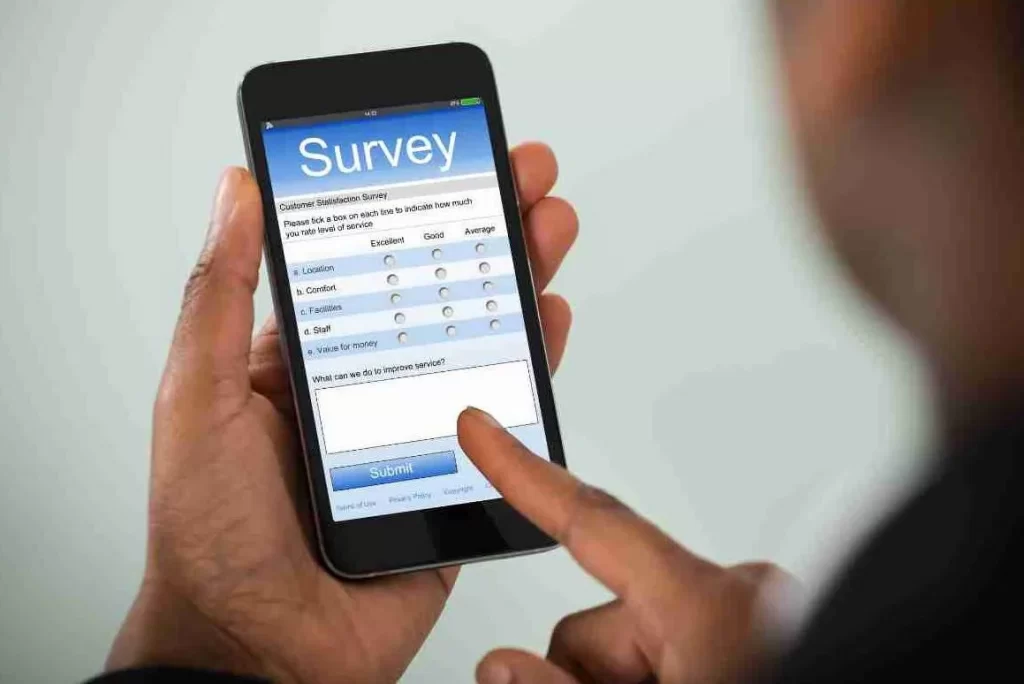There are 1 million plus restaurant locations in the US. Therefore, in today’s fiercely competitive culinary landscape, understanding and responding to customer needs is not just advantageous, it’s essential for survival and growth. For restaurant owners, customer surveys are an invaluable tool in this quest. These surveys, encompassing customer satisfaction, feedback, and loyalty, serve as a compass, guiding restaurateurs to fine-tune their offerings, enhance service quality, and ultimately, forge a strong, loyal customer base.
This article explores the benefits of conducting customer surveys and the types of questions your customer survey includes.
01. Using Customer Surveys to Gain Valuable Insights into Customer Preferences

Moreover, customer surveys are more than just questionnaires; they are a gateway to understanding your customers’ preferences. By analyzing feedback from customer satisfaction surveys, you can tailor your menu, ambiance, and service to better align with customer expectations. This adaptation based on customer insights can significantly improve the dining experience, leading to increased customer retention and attracting new patrons. When customers feel heard and see their suggestions implemented, it creates a powerful connection between them and your restaurant, enhancing their sense of belonging and loyalty.
Furthermore, these surveys offer an opportunity to identify specific preferences, such as dietary restrictions or favored cuisines, allowing for more targeted menu development. This nuanced understanding can lead to the creation of signature dishes that become the talk of the town, drawing in food enthusiasts and boosting your restaurant’s reputation.
02. Enhancing Menu and Service Based on Feedback using Customer Surveys
One of the direct benefits of customer surveys is the ability to refine your menu and service. Feedback surveys can reveal which dishes are hits or misses and highlight areas in customer service that need improvement. By responding to this feedback, you demonstrate to your customers that their opinions matter, fostering a sense of loyalty and satisfaction. This approach not only improves the existing offerings but also helps in innovating new dishes and service practices that could become your restaurant’s unique selling points.
For instance, if customers express a desire for quicker service, implementing new technologies or training staff for efficiency can greatly enhance the dining experience. Similarly, feedback on menu items can lead to the development of a menu that resonates more with your customers’ tastes, encouraging repeat visits.
Must Read: Getting the Lowdown: Why You Need to Run Customer Surveys at Your Restaurant
02. Identifying Trends and Opportunities for Innovation

Additionally, customer surveys can also help you spot emerging trends in the food and beverage industry. Customers’ changing preferences can guide you in innovating your menu or service model. For instance, a surge in interest in plant-based options or sustainable practices can be identified early through surveys, allowing your restaurant to adapt swiftly and stay ahead of the competition. This proactive approach ensures that your restaurant remains relevant and appealing to a broader customer base.
Understanding these trends is crucial in a rapidly evolving industry where customer preferences can change swiftly. By staying ahead of these trends, your restaurant can become a trendsetter, leading the way in culinary innovation and sustainable practices.
03. Improving Customer Service through Targeted Training
The feedback received from customer service surveys is invaluable for staff training. Understanding areas where your staff excels or needs improvement can guide targeted training programs. This not only enhances the customer experience but also boosts staff morale and competence. Training programs can be tailored to address specific areas, such as communication skills, handling difficult situations, or enhancing culinary expertise.
Empowering your staff with the skills and knowledge to excel not only improves service quality but also contributes to a positive work environment. This positive atmosphere is often felt by customers, further enhancing their dining experience.
04. Building Customer Loyalty and Advocacy using Customer Surveys

Subsequently, regular customers are the backbone of any successful restaurant. Customer loyalty surveys help in understanding what keeps your customers coming back. By addressing their needs and preferences, you can turn satisfied customers into loyal advocates for your brand. Loyal customers are more likely to recommend your restaurant to others, expanding your customer base organically.
Loyalty programs, informed by survey feedback, can be an effective way to reward regular customers and encourage repeat visits. These programs, tailored to meet the desires of your most loyal patrons, can range from special discounts to exclusive events, further solidifying the bond between your restaurant and its customers.
05. Streamlining Operations and Reducing Costs
Additionally, customer surveys can highlight inefficiencies in your operations that, when addressed, can lead to cost savings. Understanding customer usage patterns and preferences can help in better inventory management, reducing waste, and optimizing staffing requirements. This efficient management is not only cost-effective but also contributes to a more sustainable business model.
For example, if surveys indicate a lower demand for certain menu items, you can adjust your inventory accordingly to minimize waste. Similarly, understanding peak times and customer flow can help in efficient staffing, ensuring that you have the right number of staff at the right times, enhancing service while controlling labor costs.
06. Gaining Competitive Edge

Furthermore, in the crowded restaurant market, standing out is key. Utilizing customer feedback surveys effectively gives you a competitive edge by continually evolving and improving based on direct customer input. It shows that your restaurant values customer feedback and is committed to excellence. This commitment to customer satisfaction not only sets you apart from competitors but also fosters a positive brand image that attracts new customers
Types of Questions to Ask in Customer Surveys for Restaurants
Creating the right questions in customer surveys for restaurants is crucial for gathering actionable and meaningful data. Here are some expanded types of questions to consider:
- Rating-Based Questions: These questions ask customers to rate various aspects of their experience on a scale, such as 1-5 or 1-10. Examples include rating the quality of food, the efficiency of service, or the cleanliness of the restaurant. For instance: “On a scale of 1-5, how would you rate the overall cleanliness of our restaurant?”
- Open-Ended Questions: Open-ended questions allow customers to provide detailed feedback in their own words. This type of question is invaluable for gaining qualitative insights. Examples include asking for suggestions on menu additions or comments on the dining atmosphere. For instance: “What could we have done to make your experience with us even better?”
- Yes/No and Binary Questions: These questions are straightforward and easy for customers to answer, making them great for gathering specific information quickly. Examples include asking whether the customer would recommend the restaurant to others or if they were satisfied with the meal they received. For instance: “Did our staff greet you promptly upon arrival?”
- Multiple Choice Questions: These questions offer customers a list of options to choose from, making it easy to quantify preferences and trends. They are particularly useful for understanding customer preferences regarding menu items, special offers, or seating options. For instance: “Which of these desserts would you like to see added to our menu?”
- Demographic Questions: Understanding your customer base’s demographic can help tailor your services more effectively. Questions might include age range, dining frequency, or reasons for choosing the restaurant. However, ensure these questions are optional to respect privacy. For instance: “What age group do you belong to?”
- Follow-Up Questions: Depending on responses to certain questions, you might want to ask follow-up questions for more detail. For example, if a customer rates their experience low, a follow-up question could be: “Could you please tell us more about what didn’t meet your expectations?”
- Behavioral Questions: These questions can help you understand the patterns and preferences of your customers. For instance, asking about the frequency of their visits or the types of dishes they usually order can reveal valuable trends.
- Suggestion Box Style Questions: At the end of the survey, include an open-ended question for any additional comments or suggestions. This can provide unexpected but valuable insights. For example: “Do you have any other comments, questions, or concerns?”
Remember, the key to successful surveys is to keep them concise, relevant, and respectful of the respondent’s time and privacy. Balance different types of questions to ensure a comprehensive understanding of your customer’s experiences and preferences.
Conclusion: A Path to Sustained Growth
In conclusion, customer surveys are not just tools for gathering data; they are essential instruments for strategic growth. By effectively utilizing customer satisfaction, feedback, and loyalty surveys, restaurants can enhance their offerings, build strong relationships with customers, and stand out in a competitive market. Remember, a satisfied customer is the best business strategy of all. Start integrating these valuable tools into your restaurant’s strategy today and witness the transformation in customer experience and business success.
Must Read: How Integrating Survey Features into Self-ordering Kiosks can Help Your Restaurants











Leave a Reply